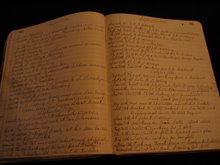The first removals of the Indian tribes to the West began in the 1790s when groups of Cherokees moved to the Arkansas River Valley. As Americans swept into their homelands, pressure on the tribes increased. During the 1830s more than 49,000 members of the Five Tribes were forced west over what became known as the Trail of Tears.
General Winfield Scott served as the person in charge of this forced move. Fort Scott, Kansas located in South-east Kansas, derived its name from this general. Established in 1842, it served as a protector for settlers against Indian attacks. The fort has been restored and is a National Historical Site. It is open to the public year round.
Saturday, December 30, 2006
Five Civilized Tribes
The Five Civilized Tribes--the Cherokee, Choctaw, Chickasaw, Creek, and Seminole--were the latgest and most numerous tribes in the Indian Territory. During the Revolutionary War they occupied lands in the Colonial Southeast, from the Carolinas and Florida to Tennessee and Mississippi.
Labels:
Carolinas,
Cherokee,
Chickasaw,
Choctaw,
Colonial Southeast,
Creek,
Florida,
Misssissippi,
Revolutionary War,
Seminole,
Tenesee
Sunday, December 24, 2006
Railroads in Oklahoma
The first railroad across the Indian Territory was built in 1871 from Vinita to Durant. Others came in 1882 and 1887. The Santa Fe line ran through the Unassigned Lands. Without the railroads, the land run of 1889 may never have happened.
Saturday, December 16, 2006
Oklahoma Panhandle
In 1889, the Panhandle of Oklahoma was under jurisdiction of no state or territory. It was truly a No Man's Land. For years it was used by ranchers when squatters arrived in 1886. A year later they formed a government and organized the area as Cimmaron Territory. The action was never approved by Congress. No Man's Land became part of Oklahoma Territory in 1890.
Sunday, December 10, 2006
Oklahoma Populated Before 1889
The land called the Indian Territory was not a wilderness in 1889. To the east of the Unassigned Lands were the Five Civilized Tribes, the Osages, and other tribes moved from previous frontiers. To the west were reservations for the Plains Tribes. In both directions were towns, railroads, newspapers, stagecoach routes, schools, and even telephone lines. It was a land with a rich legacy, a blend of many cultures and the dreams of may people. The land run 9f 1889 was only one chapter in the dramatic history of Oklahoma.
Friday, December 1, 2006
The Unassigned Lands
Did you know that when the government parcled out lands to the various Indian tribes, there was a section they forgot? It was right in the middle of what is now the state of Oklahoma. Elias C. Boudinot, a mixed-blood Cherokee lawyer discovered it and published a letter in 1879 urging the opening of the Unassigned Lands to non-Indians. He was thought to be working with the railroads and the boomers. He was called a traitor by his people. This was the land opened in 1889 for the first Oklahoma Land Run.
Labels:
Boudinot,
Indians,
Oklahoma Land Run of 1889,
Unassigned Lands
Subscribe to:
Posts (Atom)

